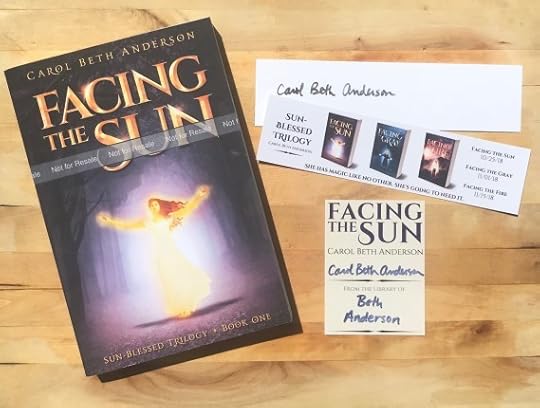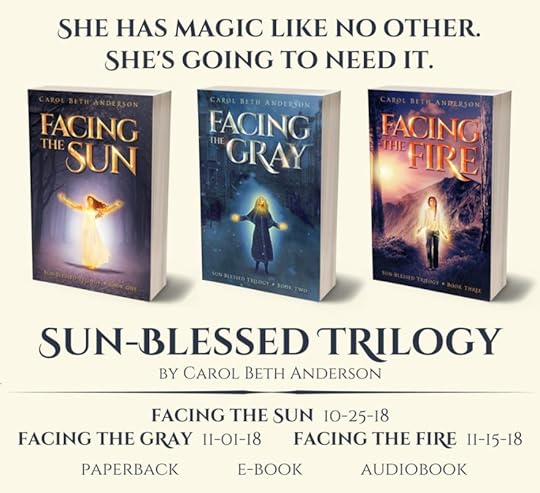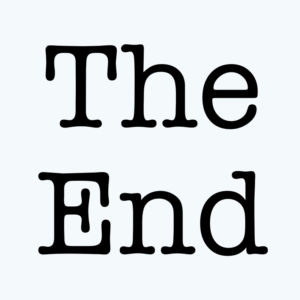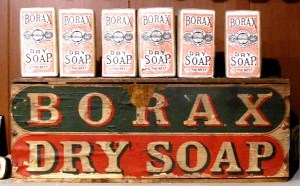Carol Beth Anderson's Blog, page 6
September 25, 2018
It’s pre-order time! (And you get free stuff for ordering early!)
Facing the Sun will be released in 30 days, and if you pre-order, I’ll send you mail with fun freebies!
Here’s what you’ll get for pre-ordering the e-book ($2.99) or paperback ($12.99):
A signed Sun-Blessed Trilogy bookmark
A signed Facing the Sun bookplate (a sticker that goes inside your book…or wherever else you want to put it)
An entry to win one of 3 signed, pre-publication proofs of the paperback version of Facing the Sun. See the photo below. I’ll do one drawing on October 4, another on October 18, and the last on October 25, the launch day. The first two winners will get the book in the mail before it’s published! Order early enough, and you could have three chances to win.

How do you get these cool perks? First, order the book! Make sure you screenshot the order confirmation, or keep the confirmation email. You’ll need that to request your perks.
Ready to pre-order? Click below!
E-books: Amazon (exclusively)
Audiobooks will be available on Audible, iTunes, and Amazon, but are not available for pre-order.
Paperback books: Amazon, Barnes & Noble (or request to special order from your local bookstore)
Signed paperbacks: Click here (and if you order the entire trilogy signed, I’ll ship them all before Book 1’s release. That means books 2 & 3 will be shipped early!)
Then, fill out this simple form.
SaveSave
SaveSave
SaveSave
SaveSave
SaveSave
SaveSave
SaveSave
SaveSave
SaveSave
SaveSave
SaveSave
SaveSave
SaveSave
SaveSave
July 17, 2018
Release dates set for the Sun-Blessed Trilogy!
The Sun-Blessed Trilogy will be released this fall! You can purchase Facing the Sun on October 25, 2018. Facing the Gray will follow on November 1, and the series will wrap up with Facing the Fire on November 15.

All three books will be available as ebooks (through Amazon), paperbacks (through Amazon, Barnes & Noble online, and plenty of other websites–and available for special order at bookstores), and audiobook (through Amazon, Audible, and iTunes).
I’m more than a little excited to share these books with you!
September 10, 2017
Bluuuuuurb!
I have spent hours, over the course of several days, writing 139 words.

That’s not really true. I’ve written a lot more than 139 words. But I have spent days choosing words, adding words, and deleting many (many, many) words. I have gotten feedback and made edits. I have rearranged and replaced and polished.
And I have a blurb.
For something so important, the term “blurb” seems trite! We could use the alternate term, “book description,” which is more dignified and more boring. Let’s stick with “blurb.” A blurb tells what a book is about. It should give you just enough information to make you want to read the book, without giving too many spoilers. You find blurbs on the backs of books and on Amazon and other online booksellers.
A book’s cover and blurb are of massive importance if an author wants people to actually read his or her book. My blurb for Facing the Sun took a lot more time to write than I expected, but I know this is one of the most vital ways for me to use my time as an independent author.
Here it is:
Magic is inherently good…but people aren’t.
Tavi Malin is born facing the sun, filled with greater magic than other sun-blessed children. When she becomes a young woman and her magic awakens, Tavi’s uncontrolled power nearly destroys her schoolhouse, leaving her confidence as shaken as her surroundings.
As Tavi and her friends learn to use their gifts, they are unaware of the threat developing in a distant city. A small group has discovered an ominous force called gray magic, and they will kill to attain it. But to seize real power, the Grays must grow their ranks—and Tavi is a prize worth pursuing.
In her stand against the Grays, Tavi will need every bit of her magic and the courage to wield it. Will she embrace her own strength, or will her self-doubt be the key to her defeat?
I hope you want to read Facing the Sun, if you didn’t already. (Or I hope it tells you this is not the book for you, which is also an important purpose of a blurb!)
The first version of this blurb was 197 words long. I got feedback, edited it, got feedback, edited more, lather, rinse, repeat. Eventually I had this version, 139 words. It felt a lot like writing poetry to me–the obsession over each and every phrase. And I enjoyed it more than I would have expected.
Book and Series Update: After finishing a major revision, I’ve sent Facing the Sun to its second group of beta readers. And I’m working on the plot for Book Two. Here we go!
July 25, 2017
Passionately using adverbs, and unnecessary commas that I use
 Editing is going well! I’ve revised the manuscript, and now I’m gradually putting it through ProWritingAid. This is a software that can detect potential improvements in my writing. It gives me suggestions on style, spelling, grammar, and more.
Editing is going well! I’ve revised the manuscript, and now I’m gradually putting it through ProWritingAid. This is a software that can detect potential improvements in my writing. It gives me suggestions on style, spelling, grammar, and more.
I love the software. It’s a lot like Grammarly, but cheaper. (And if you sign up for the free membership, be patient–a few days later, they’ll send you a coupon code for the paid version. I paid $25 for a one-year membership.)
My three biggest ProWritingAid takeaways (all demonstrated in the title of this blog post) so far are…
I use adverbs. Frequently. Some people say a creative writer should use as few adverbs as possible; others say not to worry about it. I fall somewhere in between. I think the adverb is a useful part of speech and shouldn’t be shunned–but I also think my writing will improve if I use them more sparingly. (See, that was a good use of an adverb!)
I put in a lot of unnecessary commas. I’m grateful to this program for helping me eliminate them. It’ll make my editor’s job easier too. Easier = cheaper, which is good when I’m a new author who hasn’t published any books yet.
I use the word “that” too often. I’m trying to get rid of the extras!
Soon, beta reading will begin, and I’m both nervous and excited to get the manuscript into my beta readers’ hands!
I don’t enjoy revising as much as I enjoy the initial writing process, but it’s amazing to see a creative project coming together, and these revision steps are crucial.
July 15, 2017
First Draft–done! Editing, here I come!

As of today, I have a completed first draft of my first book. Considering that I have said for decades I wanted to write a book “someday,” this feels good.
But it’s just the beginning. Now it’s time to do my own round of edits, run the manuscript through at least one proofreading software, get beta readers, and finally, get professional editing.
And that’s just Book 1. Soon I’ll be starting Book 2. And I don’t plan to publish until all three books of the trilogy are done.
So I’ll enjoy the sweetness of this day, but I don’t want to let up. It’s going to take a lot more work to have a finished product!
July 13, 2017
What is “clean fiction”?
 When I decided to write a book, I knew I wanted to write something that I’d feel comfortable sharing with my kids. I didn’t want to write a children’s book–but my kids are old enough (11 and nine) to read some really great books that I also enjoy, and I wanted these books to fall into that category. (We’ve all enjoyed the Harry Potter books, and my daughter and I both love The Hunger Games series.)
When I decided to write a book, I knew I wanted to write something that I’d feel comfortable sharing with my kids. I didn’t want to write a children’s book–but my kids are old enough (11 and nine) to read some really great books that I also enjoy, and I wanted these books to fall into that category. (We’ve all enjoyed the Harry Potter books, and my daughter and I both love The Hunger Games series.)
Another motivator for me is that I work with kids at a church, and I take that seriously. If a parent from my church finds out I’ve written books, I don’t want them to read those books and be shocked (at least not shocked in a bad way–if they find them shockingly good, I can totally live with that!) I’m not writing Christian fiction, but I want my books to be a good reflection of who I am, and faith is a huge part of that.
In the last few years, the term “clean fiction” has become more prevalent. There isn’t one definition of what makes fiction “clean.” Here’s what my version of clean fiction looks like:
Language: No cursing
Sex: Nothing graphic
Violence: Nothing overly-graphic. (This is the one area where my book wouldn’t fit some definitions of “clean fiction.” I do have murder in my book, and it’s described with some level of detail. But if someone is being strangled, I’m not going to go into exactly how much the victim’s eyes are popping out. I’d rather focus more on the emotions behind the violence, than the physical aspects of it.)
The fact that I’m writing clean fiction doesn’t mean I’m on my high horse, saying, “There’s never any need for a book to include any of that evil rubbish!” I think a well-placed curse word can be used to great effect! At this point, however, I’ve chosen to draw the line at a place where I feel comfortable as a writer, which is more conservative than where I feel comfortable as a reader. Some readers will appreciate that; others will roll their eyes–and both those responses are completely acceptable.
I have enjoyed Jeff Wheeler‘s books, and his dedication to writing clean fiction has inspired me. Are there any authors of clean fiction that you’d recommend?
P.S. When I reach 100 newsletter subscribers, I’ll announce the title of my first book! Sign up for my (totally non-spammy, cross my heart) newsletter here. We’re up to 85 subscribers…so close!
June 11, 2017
Milestones & publishing
I’ve enjoyed reaching two milestones in the last week–50,000 words, and 100 typed pages! It’s so cool to see how the words and pages add up through daily discipline.
Let’s talk a bit about publishing.
I absolutely love my Kindle, and I do nearly all my reading on it. In the never-ending debate of paper books vs. e-books, I’ve landed squarely on the electronic side.
The number of e-books available is astounding…6.7 million on Amazon. Many of these are written by independent (self-published) authors.
In the past few years, I’ve read a lot of books put out by indie authors, or by authors who started independent and were later picked up by large publishers. Before I’d decided to write my own books, I was inspired by the current publishing landscape and its friendliness to the “little guy.”
And it’s changing things, dramatically. Let’s look at Amazon, the biggest bookseller–and let’s specifically look at their top 15 bestselling sci-fi and fantasy novels right now.
The Handmaid’s Tale, Kindle edition (traditional publisher)
The Man of Legends, Kindle edition (published by 47North, part of Amazon’s own publishing arm)
Dune, Kindle edition (traditional publisher)
Harry Potter and the Sorcerer’s Stone, Kindle edition (traditional publisher)
The Hundredth Queen, Kindle edition (independent publisher)
Split Second, Kindle edition (independent publisher)
The Handmaid’s Tale, audiobook edition (traditional publisher)
Pandemic, Kindle edition (independent publisher)
The Book of Kells, Kindle edition (small publisher that only publishes e-books. This book is a rerelease of a book written in the ’80s, now in e-book format.)
The Handmaid’s Tale, paperback edition (traditional publisher)
Lost in Arcadia, Kindle edition (published by 47North, part of Amazon’s own publishing arm)
The Secret of Spellshadow Manor, Kindle edition (independent publisher)
The Gender Game, Kindle edition (independent publisher)
Make a Witch, Kindle edition (independent publisher)
1984, Kindle edition (traditional publisher)
Let’s break it down. Of the top 15 in this genre…
13 are e-books. The 2 that aren’t, are the paperback and audio versions of The Handmaid’s Tale, and its e-book is currently in the top spot.
6 are published by traditional publishers, and 6 by independent. (I’m using “independent” to mean “self-published.”)
2 are published by Amazon’s own publishing arm, which often recruits authors who have previously self-published successfully.
1 is published by a small press.
Here’s another interesting fact: The authors of #6 & #8 (Douglas E. Richards & A.G. Riddle) have both published hugely-successful books as indepdendents, then have accepted traditional contracts…and now have both returned to self-publishing. Why? Well, on Amazon you earn 70% of e-book sales when you self-publish. With a traditional publisher, they take a huge cut. Then there’s your agent. I’ve read different figures, but it seems that the most you’ll expect with traditionally-published e-books might be about 17%. That’s why independents can price their books far lower (say, $2.99 or $4.99 instead of $9.99) and still make a lot more on each copy sold.
I can see why so many people are starting independent without even trying to get an agent and a publisher. And I think that’s the direction I’m going to go. But I’m trying to go in with my eyes wide open. Currently I’m reading Write. Publish. Repeat., which is full of fantastic advice for independents
There are certainly some benefits to being signed with one of the big, traditional publishers. They do cover design and editing and typesetting for you, plus plenty of other back-end stuff. If you’re really successful, they’ll put money into marketing your book (but if you’re a small player, their marketing will be very minimal.) They can get books into traditional bookstores far easier than independents can.
But the drawbacks are numerous. It takes a long time to get a project done; the publishing company keeps most of the money; and they have a lot of creative input (which could be a positive too!)
I’m trying to keep my mind open, but I gotta say…I love the idea of not spending months or years racking up rejection letters (which is the experience of nearly all authors, even those that find “traditional” success.) I think I’d prefer to spend that time writing…and publishing.
June 3, 2017
40K and counting!
All righty, since I’m starting this blog several weeks into this crazy venture, I thought I’d do a quick update of where I am, by the numbers. For more interesting info on what “this crazy venture” is, click on “Books” in the menu. (Spoiler alert: I’m writing a book.)
Here we go!
I started brainstorming for this book on 4-22-17, started a “sample chapter” (which won’t make it into the book in its current form) on 4-26-17, and wrote the prologue on 4-27-17.
As of yesterday, I’ve written 19 chapters (plus the prologue), which is a little over 40,000 words! That’s 78 single-spaced pages in Word. I also have roughly 9,000 words in my “Brainstorm” document, which has ended up being a catch-all for world-building, outlining, etc.
So how long is a book? Good question. YA (Young Adult) books are often 60,000 to 80,000 words, but the word counts seem to be rising in recent years. Non-YA fantasy is often over 100,000 words. At the pace I’m going, I’m thinking my rough draft may clock in at about 100,000. And that’s just the first book of a series. Isn’t this exciting?!
In case you can’t tell…I’m having a blast!



